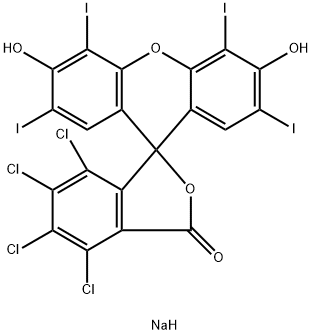| Description | Rose bengal is a xanthene dye, fluorescein derivative, and photosensitizer. It exhibits absorption/emission maxima of 548/567 nm, respectively. Rose bengal binds to S. aureus cells and decreases survival of photoirradiated S. aureus to 0.012% when used at a concentration of 1 μM. It generates singlet oxygen when exposed to photoirradiation in cell-free assays and induces potassium ion leakage from S. aureus and bovine erythrocytes in the presence of photoirradiation. Rose bengal inhibits the cytochrome P450 (CYP) isoform CYP3A4/5 and the UDP-glucuronosyltransferase (UGT) isoform UGT1A6 in human liver microsomes in a light-dependent manner, with IC50 values of 0.072 and 0.035 μM, respectively, in yellow light, 3.1 and 4.2 μM, respectively, in ambient light, and 3 and 4.2 μM, respectively, in the dark. It has been used for staining of live cells, but exhibits both intrinsic and phototoxicity. |
| Chemical Properties | bordeaux-red to red-brown crystalline powder |
| Uses | For research use only. Not for use in diagnostic procedures.
Please refer to the attached Protocolfor details. |
| Uses | Rose Bengal Sodium Salt is used in biological studies as potential for use as sensitizers in photodynamic and sonodynamic therapy by synthesizing Rose Bengal amphiphilic derivatives. This compound has neuroprotective properties. |
| General Description | This ELISA antibody pair detects Bovine IGF-1 |
| Safety Profile | An experimental teratogen. Experimental reproductive effects. Questionable carcinogen with experimental neoplastigenic data. When heated to decomposition it emits toxic fumes of Cl-, I-, and NazO. |
| Veterinary Drugs and Treatments | Rose bengal is a vital stain and stains dead epithelial cells and mucus. Full thickness loss of the corneal epithelium is not necessary (only dead cells need be present) to obtain rose bengal stain uptake. It does not stain epithelial defects and does not pass into intercellular spaces.
Rose bengal stain is most commonly employed in the detection of the presence of viral keratitis in the cat. Because feline herpes virus tends to infect one cell, moving then to an adjacent cell (causing the so called dendritic tracts in the cornea) without full thickness loss of corneal epithelium initially, rose bengal is an ideal diagnostic agent for this infection. Rose Bengal can also be used to detect damaged corneal epithelium on the dorsal cornea in early cases of keratoconjunctivitis sicca. Rose bengal stain is virucidal although no information is available relative to its use as a therapeutic agent. |
| in vitro | rose bengal was a quite potent membrane-permeant inhibitor of glutamate uptake into isolated synaptic vesicles. such vesicular glu uptake inhibition was achieved without affecting h1-pump atpase. it was found that various degrees of reduction elicited by rose bengal in [3h]glu in synaptic vesicles inside the synaptosome [1]. |
| in vivo | the distribution of i.v. administered rose bengal was found to depend on its dose. at a low dose, rose bengal could be found almost solely in the liver and plasma. however, at higher doses, the amount of rose bengal found in extra-hepatic tissues gradually increased. the hepatic transfer maximum of rose bengal amounted to 146 micrograms/kg/min. by increasing the dose from 10 to 200 mg/kg, the hepatic concentration of rose bengal also approached a maximum. the storage capacity of the liver, however, did not limit the transfer maximum of rose bengal [1]. |
| Purification Methods | This biological stain can be purified by chromatography on silica TLC using a 35:65 mix of EtOH/acetone as eluent. [Beilstein 19 II 261, 19 III/IV 2926.] |
| references | [1] ogita k,hirata k,bole dg,yoshida s,tamura y,leckenby am,ueda t. inhibition of vesicular glutamate storage and exocytotic release by rose bengal. j neurochem.2001 apr;77(1):34-42.
[2] fischer e,varga f. hepatic storage and biliary excretion of rose bengal in the rat. acta physiol acad sci hung.1979;54(1):89-94. |
